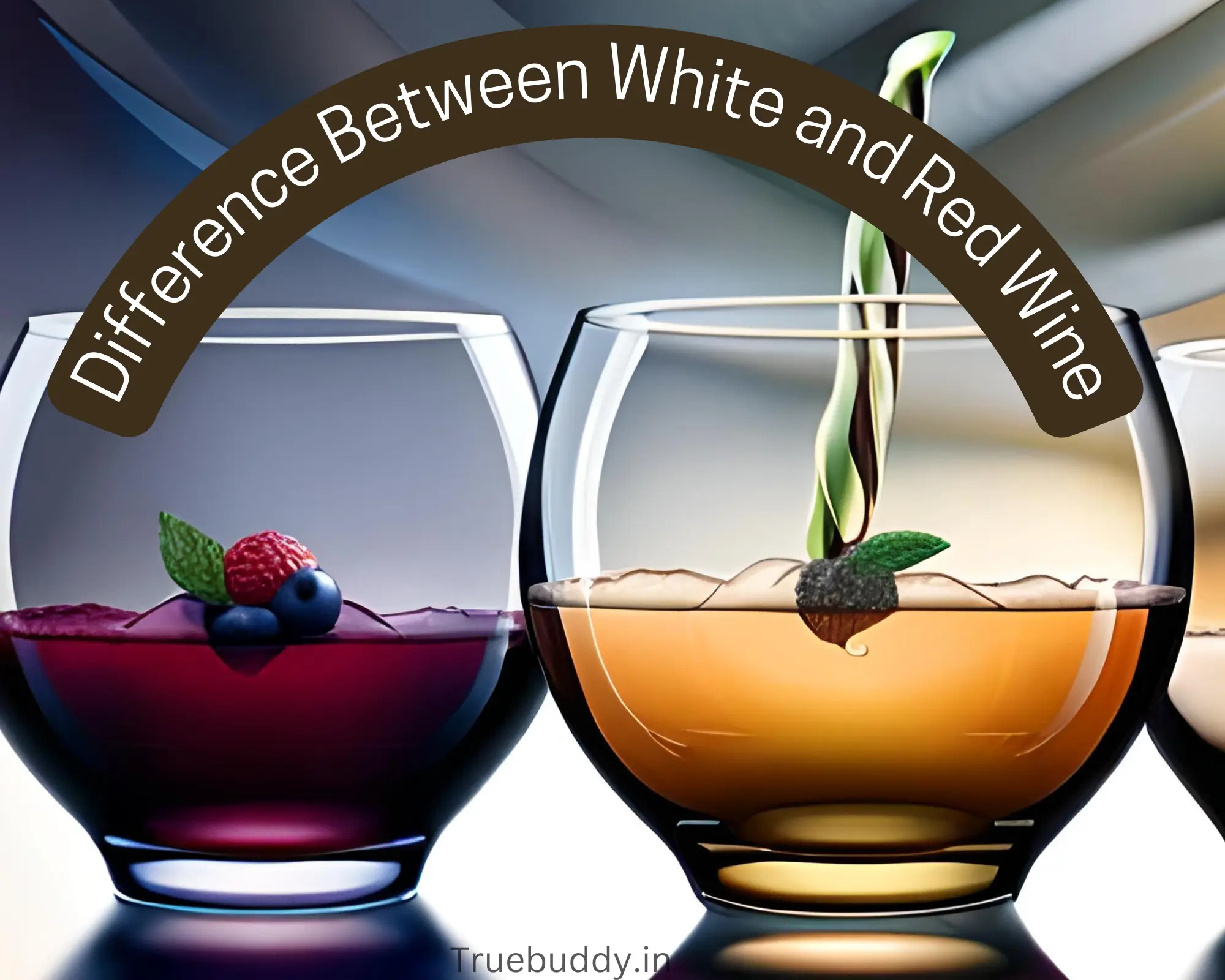Welcome to TrueBuddy
Thank you for visiting our blog on “Differences Between White Wine and Red Wine“. We have dedicated a considerable amount of time to researching and compiling this comprehensive guide to help you make an informed decision.
In this blog post, You will read:
- Key Differences Between White and Red Wine
- Factors to Consider When Choosing a Tyre Brand in India
- FAQs on Tyres
If you plan to buy any products, kindly click through our link. We may receive a small commission from the purchase you make without costing you any extra penny.
This commission will help and encourage me to write some more useful articles.
Don’t Forget to Check Out Some of the Best Deals of the Day on Amazon.
There are countless varieties and styles of wines to explore. Among the most popular choices, white wine and red wine stand out as the frontrunners. From their color to their taste profiles, these two types of wine offer distinct characteristics that appeal to different palates and occasions.
You may also like:
- Unveiling the Difference: Cocktails vs. Mocktails
- Raising a Toast to Indian Reds: The Top 10 Red Wine Brands in India
In this article, we’ll delve into the key differences between white wine and red wine, helping you understand their unique qualities and make informed choices for your wine preferences.

Differences Between White and Red Wine
1. Colour and Appearance
Colour is one of the apparent differences between white wine and red wine. When poured into a glass, white wine exhibits a pale yellow to golden hue colour . On the other hand, red wine showcases a range of deeper shades, including ruby, garnet, or even violet tones. The color variations are primarily due to the grape varieties used and the winemaking process employed.
2. Grape Varieties
The choice of grape varieties used in crafting white wine and red wine contributes significantly to their differences. White wines are mostly prepared from the grapes that has white or light green skin like Chardonnay, or Riesling. These grapes possess a lighter flesh and juice, resulting in the production of white wine with refreshing flavors and crisp acidity.
In contrast to white wines, red wine is typically produced using red or black-skinned grapes. Example of such grapes are Cabernet Sauvignon, Merlot, or Pinot Noir. The skins of these grapes lend their color and tannins to the wine during the fermentation process. This results in a richer and more complex flavor profile.
3. Fermentation Process
Another differentiating factor between white wine and red wine lies in the fermentation process. White wine is produced by fermenting the grape juice without the skin. The absence of skin contact ensures that the wine retains its light color and delicate flavors.
Red wine undergoes a process known as maceration. In this, the grape skins are left in contact with the juice during fermentation. This extended skin contact allows for the extraction of tannins, color compounds, and additional flavors from the skins, resulting in a fuller-bodied and more robust red wine.
4. Flavor Profiles
The flavor profiles of white wine and red wine are distinctively different. They offer a wide range of sensory experiences. White wine is known for its light and crisp characteristics. It often comes in flavors of citrus fruits, green apples, tropical fruits, and floral notes. It is generally served chilled and pairs well with seafood, poultry, and creamy pasta dishes.
On the other hand, red wine exhibits bolder and more complex flavors. It includes dark fruits like blackberries, plums, and cherries, along with hints of spices, chocolate, and earthy undertones. Red wines are typically served at room temperature and complement red meats, aged cheeses, and hearty dishes.
5. Serving Temperature
The recommended serving temperatures for white wine and red wine also differ due to their distinct flavor profiles. White wine is best enjoyed when chilled. I ideal serving temperatures for white wine is between 45°F and 55°F (7°C and 13°C). This cooler temperature enhances the wine’s freshness and preserves its delicate aromas.
Red wine is typically served at room temperature. Allowing red wine to breathe and reach its ideal serving temperature enhances its flavors and ensures a more enjoyable tasting experience.
6. Health Benefits
Both white wine and red wine offer health benefits, but they differ in their specific advantages. White wine contains antioxidants, such as resveratrol. It is known for its potential cardiovascular benefits. It can reduce the risk of heart disease and promote overall heart health when consumed in moderation.
Red wine is famous for its higher concentration of antioxidants and polyphenols. This is associated with various health benefits. Moderate consumption of red wine has been correlated with a lower risk of heart disease and certain types of cancer.
7. Aging Potential
Another aspect that sets white wine apart from red wine is its aging potential. In general, white wines are best consumed within a few years of their vintage. They are prized for their youthful and vibrant characteristics, with flavors at their peak during the first few years after bottling.
On the contrary, many red wines possess the ability to age gracefully. With their higher tannin content and complex structure, certain red wines can evolve and develop more nuanced flavors over time. Some red wines can be aged for several decades. It helps them to reach their full potential and offer a truly exceptional tasting experience.
8. Popularity and Food Pairings
White wine and red wine have their own dedicated fan bases and popularity in different regions and cultures. White wine, with its refreshing and lighter profile, is often favored during warmer months and social gatherings. It pairs well with dishes like seafood, salads, light pasta, and appetizers.
Red wine is revered for its depth and versatility. It is a popular choice for cozy evenings, celebrations, and special occasions. Red wine pairs excellently with red meats, game, hearty stews, aged cheeses, and dark chocolate.
9. The Importance of Personal Preference
Ultimately, the choice between white wine and red wine depends on personal preference. Each wine type offers its own unique characteristics, and exploring different styles can be an enjoyable journey for wine enthusiasts. There is a vast world of options to discover and savor. The choice is all yours to choose between the vibrant and crisp nature of white wine or the bold and complex flavors of red wine.
FAQs on Red Wine and White Wine
What’s the basic difference between white wine and red wine?
The main difference lies in the grape varieties used and the fermentation process. White wine is made from white or green grapes, while red wine is made from dark-colored grapes. Also, the red wine is fermented with the grape skins, while the white wine is not.
What is the difference between the flavors of white wine and red wine?
White wine has lighter and crisper flavors, with notes of citrus, apple, and floral aromas. Red wine tends to have bolder flavors, such as dark fruits like blackberries and cherries.
Which foods pair well with white wine?
White wine pairs well with lighter dishes such as seafood, salads, poultry, and creamy sauces. It complements the flavors and refreshes the palate.
What types of foods go well with red wine?
Red wine pairs well with hearty dishes like red meat, pasta with red sauce, aged cheeses, and dark chocolate. The robust flavors of red wine enhance the richness of these foods.
Can white wine be aged like red wine?
Most white wines are meant to be consumed young and fresh.
How long can white wine and red wine be stored after opening?
White wine is typically best consumed within a few days of opening if stored properly in the refrigerator. Red wine can be stored for a slightly longer period, usually up to a week Make sure you stored it in a cool and dark place.
Can you mix white wine and red wine?
While it’s not common practice to mix white wine and red wine, some individuals enjoy creating unique blends by mixing the two. However, it’s essential to note that this is a matter of personal preference and may not yield the intended flavor profile.
Conclusion
The differences between white wine and red wine are evident in their color, grape varieties, fermentation processes, flavor profiles, serving temperatures, health benefits, aging potential, and popularity. While white wine captivates with its lightness and refreshing qualities, red wine enchants with its richness and depth. So, whether you raise a glass of white or red, may your wine experience be filled with enjoyment, exploration, and delightful flavors.
Wine appreciation is subjective, and the best wine is the one that brings you joy and pleasure! Cheers to discovering the wonderful world of wines!
